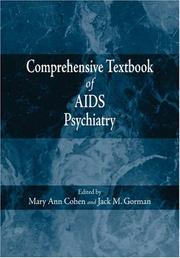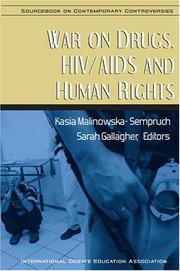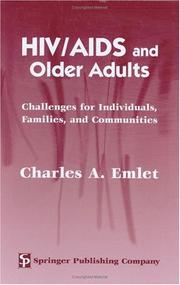| Listing 1 - 10 of 36 | << page >> |
Sort by
|
Book
ISBN: 1282259768 9786612259760 0821379798 082137933X Year: 2009 Publisher: Washington, D.C. : World Bank,
Abstract | Keywords | Export | Availability | Bookmark
 Loading...
Loading...Choose an application
- Reference Manager
- EndNote
- RefWorks (Direct export to RefWorks)
Courage and Hope gives voice to the real life experiences of 12 HIV-positive teachers, five of whom are women, from Burkina Faso, Cameroon, Ghana, Kenya, Mozambique, Rwanda, Senegal, Tanzania (both Mainland and Zanzibar) and Zambia. The teachers recount their experiences of discovering their HIV-positive status and how this has affected them in their families, their communities, and their professional lives. Their stories are documented by journalists, emphasizing the human dimension. The voices of these teachers suggest that a number of obstacles are commonly faced by teachers living with HIV
HIV-positive persons --- Teachers --- Social conditions. --- Health and hygiene --- Faculty (Education) --- Instructors --- School teachers --- Schoolteachers --- HIV-infected persons --- HIV infections --- HIV patients --- HIV-sero-positive persons --- HIV-seropositive persons --- People living with HIV/AIDS --- Positive persons, HIV --- -Sero-positive persons, HIV --- -Seropositive persons, HIV --- -Social conditions. --- Patients --- School employees --- -Patients
Book
ISBN: 9780822358084 0822358085 9780822357957 082235795X 0822375974 Year: 2014 Publisher: Durham : Duke University Press,
Abstract | Keywords | Export | Availability | Bookmark
 Loading...
Loading...Choose an application
- Reference Manager
- EndNote
- RefWorks (Direct export to RefWorks)
AIDS (Disease) --- HIV-positive persons --- Patients --- HIV-infected persons --- HIV infections --- HIV patients --- HIV-sero-positive persons --- HIV-seropositive persons --- People living with HIV/AIDS --- Positive persons, HIV --- -Sero-positive persons, HIV --- -Seropositive persons, HIV --- -Patients --- Acquired immune deficiency syndrome --- Acquired immunodeficiency syndrome --- Acquired immunological deficiency syndrome --- Immunological deficiency syndromes --- Virus-induced immunosuppression

ISBN: 1281162965 9786611162962 0198041411 1435600940 9780198041412 9780195304350 0195304357 9781281162960 6611162968 9781435600942 Year: 2008 Publisher: Oxford ; New York : Oxford University Press,
Abstract | Keywords | Export | Availability | Bookmark
 Loading...
Loading...Choose an application
- Reference Manager
- EndNote
- RefWorks (Direct export to RefWorks)
Among the vast and rapidly growing field of AIDS research, there is an ample body of evidence supporting the fact that psychiatric treatment can decrease transmission, diminish suffering, improve adherence, and decrease morbidity and mortality. There is probably no other illness in which the connections between mind and body are so inextricably woven. But until now there has been no comprehensive textbook of AIDS psychiatry to guide clinicians towards providing much needed care. Using a biopsychosocial approach, this 41-chapter volume offers insight into the interface between the psychiatric,
AIDS (Disease) --- HIV infections --- HIV-positive persons --- HIV-infected persons --- HIV patients --- HIV-sero-positive persons --- HIV-seropositive persons --- People living with HIV/AIDS --- Positive persons, HIV --- -Sero-positive persons, HIV --- -Seropositive persons, HIV --- -Patients --- HIV (Viruses) infections --- HTLV-III infections --- HTLV-III-LAV infections --- Human T-lymphotropic virus III infections --- Lentivirus infections --- Sexually transmitted diseases --- Psychological aspects. --- Patients --- Mental health.
Book
ISBN: 1612495834 1612495826 9781612495828 9781612495835 9781557538437 Year: 2019 Publisher: Ashland
Abstract | Keywords | Export | Availability | Bookmark
 Loading...
Loading...Choose an application
- Reference Manager
- EndNote
- RefWorks (Direct export to RefWorks)
HIV-positive persons --- Human-animal relationships --- AIDS (Disease) --- Acquired immune deficiency syndrome --- Acquired immunodeficiency syndrome --- Acquired immunological deficiency syndrome --- HIV infections --- Immunological deficiency syndromes --- Virus-induced immunosuppression --- HIV-infected persons --- HIV patients --- HIV-sero-positive persons --- HIV-seropositive persons --- People living with HIV/AIDS --- Positive persons, HIV --- -Sero-positive persons, HIV --- -Seropositive persons, HIV --- -Patients --- Patients
Book
ISBN: 0813560993 0813560985 Year: 2013 Publisher: New Brunswick, N.J. : Rutgers University Press,
Abstract | Keywords | Export | Availability | Bookmark
 Loading...
Loading...Choose an application
- Reference Manager
- EndNote
- RefWorks (Direct export to RefWorks)
One of the most relevant social problems in contemporary American life is the continuing HIV epidemic in the Black population. With vivid ethnographic detail, this book brings together scholarship on the structural dimensions of the AIDS epidemic and the social construction of sexuality to assert that shifting forms of sexual stories—structural intimacies—are emerging, produced by the meeting of intimate lives and social structural patterns. These stories render such inequalities as racism, poverty, gender power disparities, sexual stigma, and discrimination as central not just to the dramatic, disproportionate spread of HIV in Black communities in the United States, but to the formation of Black sexualities. Sonja Mackenzie elegantly argues that structural vulnerability is felt—quite literally—in the blood, in the possibilities and constraints on sexual lives, and in the rhetorics of their telling. The circulation of structural intimacies in daily life and in the political domain reflects possibilities for seeking what Mackenzie calls intimate justice at the nexus of cultural, economic, political, and moral spheres. Structural Intimacies presents a compelling case: in an era of deepening medicalization of HIV/AIDS, public health must move beyond individual-level interventions to community-level health equity frames and policy changes
HIV-positive persons --- African Americans --- AIDS (Disease) --- Afro-Americans --- Black Americans --- Colored people (United States) --- Negroes --- Africans --- Ethnology --- Blacks --- HIV-infected persons --- HIV infections --- HIV patients --- HIV-sero-positive persons --- HIV-seropositive persons --- People living with HIV/AIDS --- Positive persons, HIV --- -Sero-positive persons, HIV --- -Seropositive persons, HIV --- -Patients --- Social conditions. --- Diseases --- Social aspects --- Patients --- Black people
Book
ISBN: 9781553653103 1553653106 Year: 2009 Publisher: Vancouver Douglas and McIntyre
Abstract | Keywords | Export | Availability | Bookmark
 Loading...
Loading...Choose an application
- Reference Manager
- EndNote
- RefWorks (Direct export to RefWorks)
In the 100 days of genocide that ravaged Rwanda in 1994, one million people were killed and as many as 500,000 women and girls were raped. No one was spared. Grandmothers were raped in front of their grandchildren; young girls witnessed their families being massacred before being taken as sex slaves. Nearly all the women who survived were victims of sexual violence or were profoundly affected by it. An astounding 70 percent are HIV-positive. In Rwanda’s social and cultural climate, survivors who speak out face discrimination and isolation. The Men Who Killed Me features testimonials from 17 Rwandan survivors. Through their narratives and Samer Muscati’s powerful portraits of them, these 16 women and one man bear witness not only to the crimes they and their countrymen endured, but to the incredible courage that has allowed them to survive and flourish.
Genocide --- HIV-positive persons --- Sexual abuse victims --- Women and war --- Women --- Human females --- Wimmin --- Woman --- Womon --- Womyn --- Females --- Human beings --- Femininity --- War and women --- War --- Women and the military --- Female sexual abuse victims --- Sexual violence victims --- Victims of sex crimes --- Victims of crimes --- HIV-infected persons --- HIV infections --- HIV patients --- HIV-sero-positive persons --- HIV-seropositive persons --- People living with HIV/AIDS --- Positive persons, HIV --- -Sero-positive persons, HIV --- -Seropositive persons, HIV --- -Patients --- Violence against --- Patients

ISBN: 141757593X 9781417575930 9780972054171 0972054170 Year: 2004 Publisher: New York International Debate Education Association
Abstract | Keywords | Export | Availability | Bookmark
 Loading...
Loading...Choose an application
- Reference Manager
- EndNote
- RefWorks (Direct export to RefWorks)
Drug abuse --- HIV-positive persons --- AIDS (Disease) --- Acquired immune deficiency syndrome --- Acquired immunodeficiency syndrome --- Acquired immunological deficiency syndrome --- HIV infections --- Immunological deficiency syndromes --- Virus-induced immunosuppression --- HIV-infected persons --- HIV patients --- HIV-sero-positive persons --- HIV-seropositive persons --- People living with HIV/AIDS --- Positive persons, HIV --- -Sero-positive persons, HIV --- -Seropositive persons, HIV --- -Patients --- Drug use --- Substance abuse --- Government policy. --- Drug use. --- Civil rights. --- Patients

ISBN: 1281964387 9786611964382 0826197698 9780826197696 9780826144959 0826144950 9781281964380 0826144950 661196438X Year: 2004 Publisher: New York, NY Springer Pub. Co.
Abstract | Keywords | Export | Availability | Bookmark
 Loading...
Loading...Choose an application
- Reference Manager
- EndNote
- RefWorks (Direct export to RefWorks)
This volume focuses on the ways in which HIV/AIDS can affect older adults. The chapters in this book discuss the variety of HIV/AIDS problems that we face at the individual, family, and community levels. Topics examined include demographics and epidemiological aspects of HIV disease with this population; prevention of HIV disease; issues impacting individuals in a medical, psychological, and social context; and service needs. Originally published as a special issue of the Journal of Mental Health and Aging, the volume contains new chapters on demographics, HIV prevention and education, and eff
AIDS (Disease) in old age. --- AIDS (Disease) in old age --- Older people --- HIV-positive persons. --- AIDS (Disease) --- HIV infections --- HIV (Viruses) infections --- HTLV-III infections --- HTLV-III-LAV infections --- Human T-lymphotropic virus III infections --- Lentivirus infections --- Sexually transmitted diseases --- HIV-infected persons --- HIV patients --- HIV-sero-positive persons --- HIV-seropositive persons --- People living with HIV/AIDS --- Positive persons, HIV --- -Sero-positive persons, HIV --- -Seropositive persons, HIV --- -Patients --- Geriatrics --- Social aspects. --- Health and hygiene. --- Age factors. --- Patients --- Diseases
Book
ISBN: 0197562663 0199706972 9780199706976 9780195372571 0195372573 Year: 2010 Publisher: Oxford New York
Abstract | Keywords | Export | Availability | Bookmark
 Loading...
Loading...Choose an application
- Reference Manager
- EndNote
- RefWorks (Direct export to RefWorks)
The Handbook of AIDS Psychiatry is a practical guide for AIDS psychiatrists and other mental health professionals as well as for other clinicians who work with persons with HIV and AIDS and a companion book to the Comprehensive Textbook of AIDS Psychiatry (Cohen and Gorman, 2008). The Handbook provides insights into the dynamics of adherence to risk reduction and medical care in persons with HIV and AIDS as well as strategies to improve adherence using a biopsychosocial approach.
AIDS (Disease) --- HIV infections --- HIV-positive persons --- HIV-infected persons --- HIV patients --- HIV-sero-positive persons --- HIV-seropositive persons --- People living with HIV/AIDS --- Positive persons, HIV --- -Sero-positive persons, HIV --- -Seropositive persons, HIV --- -Patients --- Acquired immune deficiency syndrome --- Acquired immunodeficiency syndrome --- Acquired immunological deficiency syndrome --- Immunological deficiency syndromes --- Virus-induced immunosuppression --- HIV (Viruses) infections --- HTLV-III infections --- HTLV-III-LAV infections --- Human T-lymphotropic virus III infections --- Lentivirus infections --- Sexually transmitted diseases --- Psychological aspects --- Patients --- Mental health
Book
ISBN: 178308507X 1783085045 Year: 2016 Publisher: London, UK ; New York, NY : Anthem Press, an imprint of Wimbledon Publishing Company,
Abstract | Keywords | Export | Availability | Bookmark
 Loading...
Loading...Choose an application
- Reference Manager
- EndNote
- RefWorks (Direct export to RefWorks)
This book addresses the major challenge for HIV prevention: that is, to reach beyond the limitations of biomedical approaches to disease and to design prevention strategies informed by and connected with the social realities of people's lives.
HIV infections --- AIDS (Disease) --- HIV-positive persons --- HIV (Viruses) infections --- HTLV-III infections --- HTLV-III-LAV infections --- Human T-lymphotropic virus III infections --- Lentivirus infections --- Sexually transmitted diseases --- HIV-infected persons --- HIV patients --- HIV-sero-positive persons --- HIV-seropositive persons --- People living with HIV/AIDS --- Positive persons, HIV --- -Sero-positive persons, HIV --- -Seropositive persons, HIV --- -Patients --- Acquired immune deficiency syndrome --- Acquired immunodeficiency syndrome --- Acquired immunological deficiency syndrome --- Immunological deficiency syndromes --- Virus-induced immunosuppression --- Prevention. --- Social aspects. --- Sexual behavior. --- Patients
| Listing 1 - 10 of 36 | << page >> |
Sort by
|

 Search
Search Feedback
Feedback About UniCat
About UniCat  Help
Help News
News